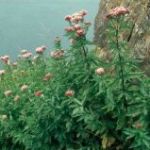| Common Name: |
Hemp Agrimony |
| Botanical Name: |
Eupatorium cannabinum |
| Genus: |
Eupatorium |
| Family: |
Asteraceae |
| Native Location: |
Europe |
| Cultivation: |
Moist soul in sun or partial shade. Cut stems almost to ground level in autumn after flowering. Eupatorium purpureum prefers alkaline soil. Some species are subject to statuatory controls as weeds in parts of Australia. |
| Propagation: |
By seed sown in spring; by division in spring. |
| Harvest: |
Plants are cut when in bud, and dried for use in infusions, liquid extracts, tinctures. Rhizomes and roots are lifted in autumn, and dried for use in decoctions or tinctures. |
| Height: |
30cm-1.5m (1-5ft) |
| Width: |
1.2m (4ft) |
| Variations: |
Flore Pleno
Has double, longer lasting flowers. |
| Hardiness: |
Z5-9 |
| Parts Used: |
Whole Plant |
| Properties: |
A bitter-sweet, slightly aromatic herb that is diuretic and has a tonic effect, stimulating the immune system and arresting the growth of tumors. It contains pyrrolizidine alkaloids that may cause damage or cancer to the liver. |
| Medicinal Uses: |
Internally for arthritis, rheumatism, feverish colds, and influenza. Excess is purgative and emetic. Combined with other herbs as a tonic for low energy with biliousness or constipation. Externally for ulcers, sores, and as an insect repellent for animals. Used in homeopathic tinctures for influenza. |
| Bibliography: |
Encyclopedia of Herbs by Deni Brown Copyright © 1995, 2001 Dorling Kindersley Limited Pp 208-209 |
